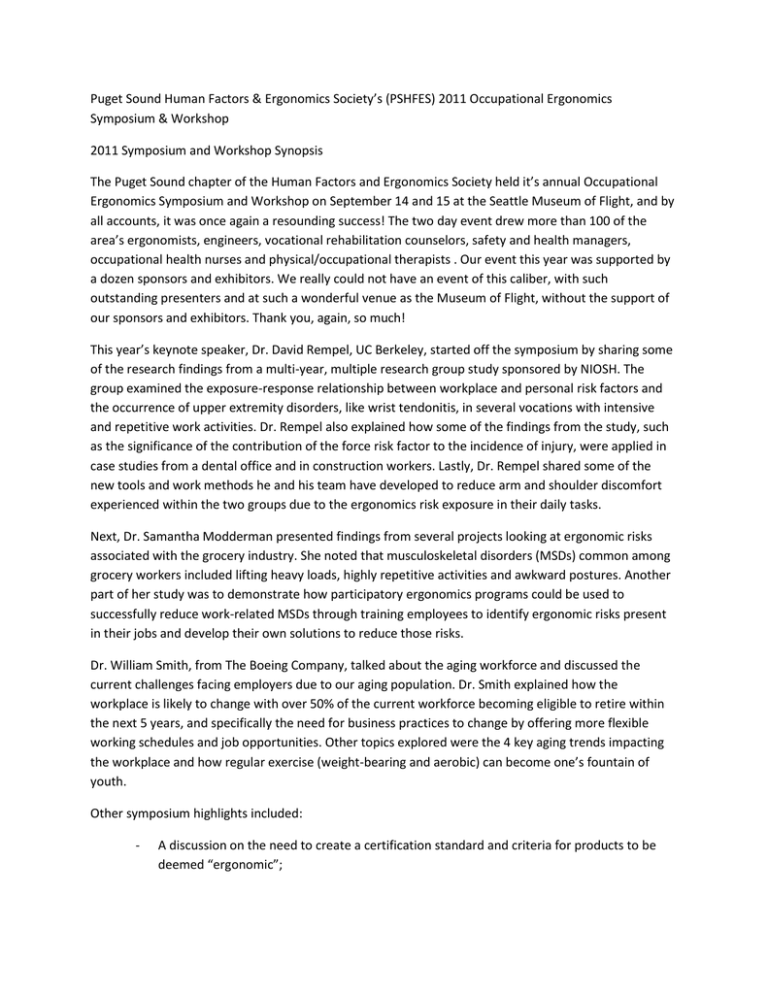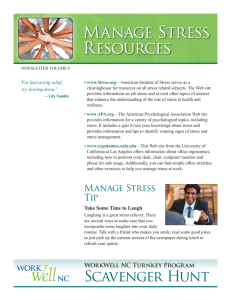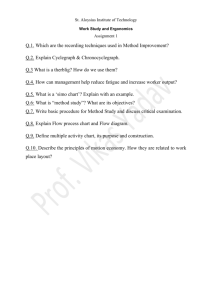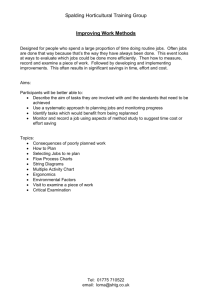2011 Occupational Ergonomics Symposium & Workshop
advertisement

Puget Sound Human Factors & Ergonomics Society’s (PSHFES) 2011 Occupational Ergonomics Symposium & Workshop 2011 Symposium and Workshop Synopsis The Puget Sound chapter of the Human Factors and Ergonomics Society held it’s annual Occupational Ergonomics Symposium and Workshop on September 14 and 15 at the Seattle Museum of Flight, and by all accounts, it was once again a resounding success! The two day event drew more than 100 of the area’s ergonomists, engineers, vocational rehabilitation counselors, safety and health managers, occupational health nurses and physical/occupational therapists . Our event this year was supported by a dozen sponsors and exhibitors. We really could not have an event of this caliber, with such outstanding presenters and at such a wonderful venue as the Museum of Flight, without the support of our sponsors and exhibitors. Thank you, again, so much! This year’s keynote speaker, Dr. David Rempel, UC Berkeley, started off the symposium by sharing some of the research findings from a multi-year, multiple research group study sponsored by NIOSH. The group examined the exposure-response relationship between workplace and personal risk factors and the occurrence of upper extremity disorders, like wrist tendonitis, in several vocations with intensive and repetitive work activities. Dr. Rempel also explained how some of the findings from the study, such as the significance of the contribution of the force risk factor to the incidence of injury, were applied in case studies from a dental office and in construction workers. Lastly, Dr. Rempel shared some of the new tools and work methods he and his team have developed to reduce arm and shoulder discomfort experienced within the two groups due to the ergonomics risk exposure in their daily tasks. Next, Dr. Samantha Modderman presented findings from several projects looking at ergonomic risks associated with the grocery industry. She noted that musculoskeletal disorders (MSDs) common among grocery workers included lifting heavy loads, highly repetitive activities and awkward postures. Another part of her study was to demonstrate how participatory ergonomics programs could be used to successfully reduce work-related MSDs through training employees to identify ergonomic risks present in their jobs and develop their own solutions to reduce those risks. Dr. William Smith, from The Boeing Company, talked about the aging workforce and discussed the current challenges facing employers due to our aging population. Dr. Smith explained how the workplace is likely to change with over 50% of the current workforce becoming eligible to retire within the next 5 years, and specifically the need for business practices to change by offering more flexible working schedules and job opportunities. Other topics explored were the 4 key aging trends impacting the workplace and how regular exercise (weight-bearing and aerobic) can become one’s fountain of youth. Other symposium highlights included: - A discussion on the need to create a certification standard and criteria for products to be deemed “ergonomic”; - - Two Ford Company human factors and ergonomics professionals demonstrated how they use virtual analysis tools in the ergonomic design of their products and manufacturing processes to achieve major reductions (>80%) in employee injury risk, as well as to optimize performance and design quality into the manufacturing process; and, A delightful photographic journey and study of the redesign of coffee harvest bags to reduce MSDs and improve productivity in Nicaraguan coffee harvesters showed some of the challenges of research in a different culture and developing country. Lastly, the symposium wouldn’t have been complete without the presentation of this year’s Ergonomics Professional of the Year award which recognizes a person or group who has worked to advance the subject of human factors and ergonomics, educate others and promote awareness in the field. This year’s recipient of the Ergonomics Professional of the year award went to Susan Murphey, President of Essential Ergonomics. Susan has been an active PSHFES member and part of the Council for many years, a published author and international speaker in ergonomics and work wellness programs, and has been a driving force in starting the Technically Cool Computing project, a computer and ergonomic learning activity module to teach students how to evaluate their computer workstations and reduce exposure to ergonomic risks. A well deserved “Congratulations” and thank you goes to Susan Murphey for her outstanding work in the field of ergonomics. The second day was devoted to our workshop on The Integration of Lean and Ergonomics. Jeff Smagacz, from RMG Consulting in Nashville, TN provided the morning lecture on basic Lean concepts and how they relate to the application of ergonomics principles. His focus was on the eight commonly recognized Lean wastes, how each impact the ergonomics risks in jobs, and how the elimination of both wastes and ergonomics risk leads to the production of products for less cost and an improvement in quality and safety. The waste with the largest effect on ergonomics is motion; with bending, reaching, and carrying being examples of motions that contain both wasteful motions, causing increased cycle time in the process and ergonomics risks, causing increased potential for injury. These ideas were carried over into the afternoon where Deborah Read, president of ErgoFit Consulting, shared a cost of motion calculator example, and Barb Faville, ergonomist from The Boeing Company, gave a presentation on using Lean concepts in the development of ergonomics solutions. The workshop attendees then participated in exercises to reinforce the ideas presented in these discussions by trying to improve ergonomics and quality through the removal of wasteful motions in a manufacturing task (using plastic balls) and “Leaning Out” a Big Box Warehouse Store’s delivery process.




